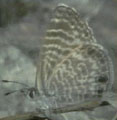Native Plants
Search for native plants by scientific name, common name or family. If you are not sure what you are looking for, try the Combination Search or our Recommended Species lists.
Senegalia wrightii
Senegalia wrightii (Benth.) Britton & Rose
Wright Acacia, Wright's Acacia, Catclaw Acacia, Catclaw
Fabaceae (Pea Family)
Synonym(s): Acacia greggii var. wrightii
USDA Symbol: SEWR4
USDA Native Status: L48 (N)
This small tree may be shrub-like, up to about 10 feet tall, or a small tree up to about 30 feet tall. Its branches are armed with catclaw-like prickles and bear creamy-white flowers in 2 in. spikes. The delicate foliage is pinnately-compound, and semi-evergreen.
This species is named in honor of Charles Wright, 1811-1885, world-wide botanical collector but mainly in Texas (1837-1852), Cuba and his native Connecticut.
Plant Characteristics
Duration: PerennialHabit: Tree
Leaf Retention: Deciduous , Semi-evergreen
Leaf Arrangement: Alternate
Leaf Complexity: Pinnate
Leaf Shape: Obovate
Leaf Margin: Entire
Fruit Type: Legume
Size Notes: Height 20 to 30 feet, spread 20 to 30 feet.
Flower: Flowers in 2 inch spikes
Fruit: Brown
Bloom Information
Bloom Color: White , YellowBloom Time: Mar , Apr , May
Distribution
USA: NM , TXNative Distribution: Central Texas west to New Mexico and south to Nuevo Leon in Mexico
Native Habitat: Stream, river banks, Canyons, Chaparral & brush country, Open woodlands. Dry, rocky, open sites; brushlands along creeks; canyons.
Growing Conditions
Water Use: LowLight Requirement: Sun , Part Shade
Soil Moisture: Dry
Drought Tolerance: High
Soil Description: Caliche type, Limestone-based, Sandy, Sandy Loam, Medium Loam, Clay Loam Clay
Conditions Comments: This shrub or small tree's branches are armed with catclaw-like prickles and bear creamy-white flowers in 2 in. spikes. The delicate foliage is pinnately-compound, and semi-evergreen.
Benefit
Use Ornamental: Showy, Understory tree, Attractive, Blooms ornamental, ScreensUse Wildlife: Nectar-bees, Cover, Nesting site.
Conspicuous Flowers: yes
Attracts: Butterflies
Larval Host: Marine blue butterfly
Butterflies and Moths of North America (BAMONA)
|
Marine Blue (Leptotes marina)  Larval Host |
Propagation
Propagation Material: SeedsDescription: Untreated seed.
Seed Collection: Late summer to early fall when seeds are firm, filled out, and dark brown.
Seed Treatment: No treatment necessary.
Commercially Avail: yes
Maintenance: Requires pruning to develop strong structure.
From the National Organizations Directory
According to the species list provided by Affiliate Organizations, this plant is on display at the following locations:Lady Bird Johnson Wildflower Center - Austin, TX
Texas Discovery Gardens - Dallas, TX
Brackenridge Field Laboratory - Austin, TX
Texas Parks and Wildlife Department - Austin, TX
Bibliography
Bibref 298 - Field Guide to Texas Trees (1999) Simpson, B.J.Bibref 355 - Landscaping with Native Plants of Texas and the Southwest (1991) Miller, G. O.
Bibref 318 - Native Texas Plants: Landscaping Region by Region (2002) Wasowski, S. & A. Wasowski
Bibref 291 - Texas Wildscapes: Gardening for Wildlife (1999) Damude, N. & K.C. Bender
Bibref 297 - Trees of Central Texas (1984) Vines, Robert A.
Search More Titles in Bibliography
Additional resources
USDA: Find Senegalia wrightii in USDA PlantsFNA: Find Senegalia wrightii in the Flora of North America (if available)
Google: Search Google for Senegalia wrightii
Metadata
Record Modified: 2021-09-12Research By: TWC Staff